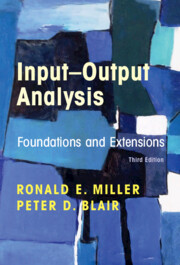Book contents
- Input–Output Analysis
- Input–Output Analysis
- Copyright page
- Contents
- Figures
- Tables
- Preface
- 1 Introduction and Overview
- 2 Foundations of Input–Output Analysis
- 3 Input–Output Models at the Regional Level
- 4 Organization of Basic Data for Input–Output Models
- 5 The Commodity-by-Industry Approach in Input–Output Models
- 6 Multipliers in the Input–Output Model
- 7 Supply-Side Models, Linkages, and Important Coefficients
- 8 Decomposition Approaches
- 9 Nonsurvey and Partial-Survey Methods:
- 10 Nonsurvey and Partial-Survey Methods:
- 11 Social Accounting Matrices
- 12 Energy Input–Output Analysis
- 13 Environmental Input–Output Analysis
- 14 Mixed and Dynamic Models
- 15 Additional Topics
- Postscript
- Book part
- Author Index
- Subject Index
Postscript
Published online by Cambridge University Press: 06 January 2022
- Input–Output Analysis
- Input–Output Analysis
- Copyright page
- Contents
- Figures
- Tables
- Preface
- 1 Introduction and Overview
- 2 Foundations of Input–Output Analysis
- 3 Input–Output Models at the Regional Level
- 4 Organization of Basic Data for Input–Output Models
- 5 The Commodity-by-Industry Approach in Input–Output Models
- 6 Multipliers in the Input–Output Model
- 7 Supply-Side Models, Linkages, and Important Coefficients
- 8 Decomposition Approaches
- 9 Nonsurvey and Partial-Survey Methods:
- 10 Nonsurvey and Partial-Survey Methods:
- 11 Social Accounting Matrices
- 12 Energy Input–Output Analysis
- 13 Environmental Input–Output Analysis
- 14 Mixed and Dynamic Models
- 15 Additional Topics
- Postscript
- Book part
- Author Index
- Subject Index
Summary
In this text we have developed the basic framework of input–output analysis and many of the extensions and applications that followed Professor Leontief’s seminal work defining the field nearly seven decades ago (chronicled in Appendix C). To this day, input–output and its extensions endure by themselves as tools for many kinds of economic analysis. The basic framework often comprises a fundamental component of many other types of economic analysis as well, such as econometric general equilibrium and planning models, and extensions also include applications to broader social accounting problems, such as social accounting matrices, ecological analysis, tracing material or energy use and flow throughout an economy measured in physical terms, or defining material or environmental footprints for firms, regions, or nations. We have captured many, and perhaps most, but not all these extensions and applications to varying degrees of detail in this text.
- Type
- Chapter
- Information
- Input-Output AnalysisFoundations and Extensions, pp. 751 - 752Publisher: Cambridge University PressPrint publication year: 2022

